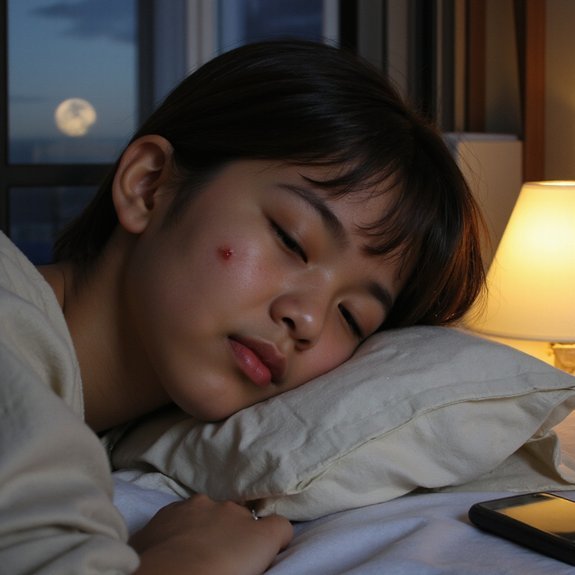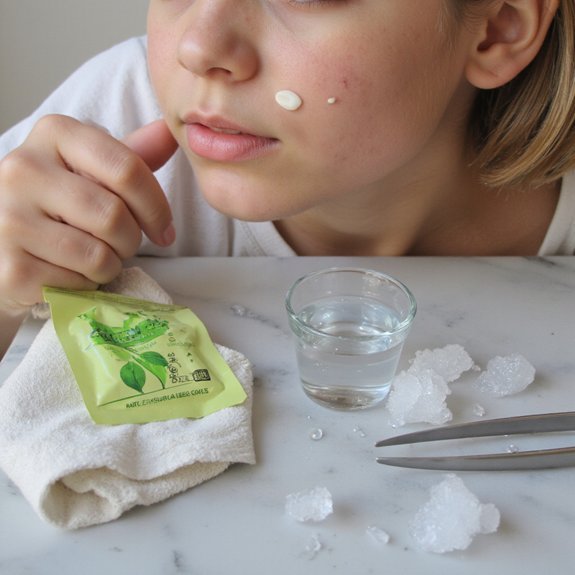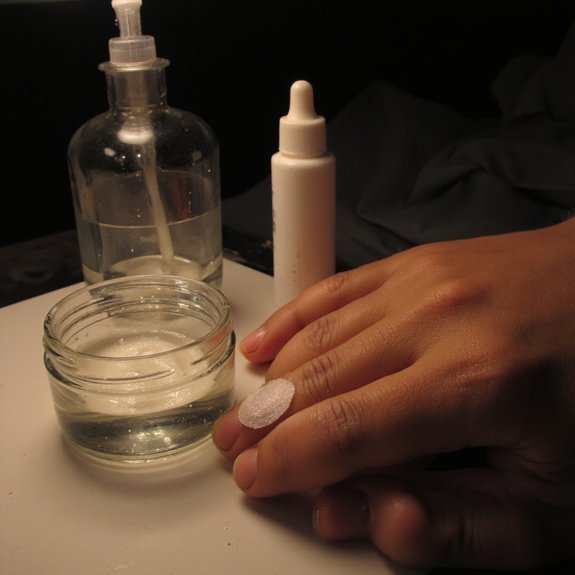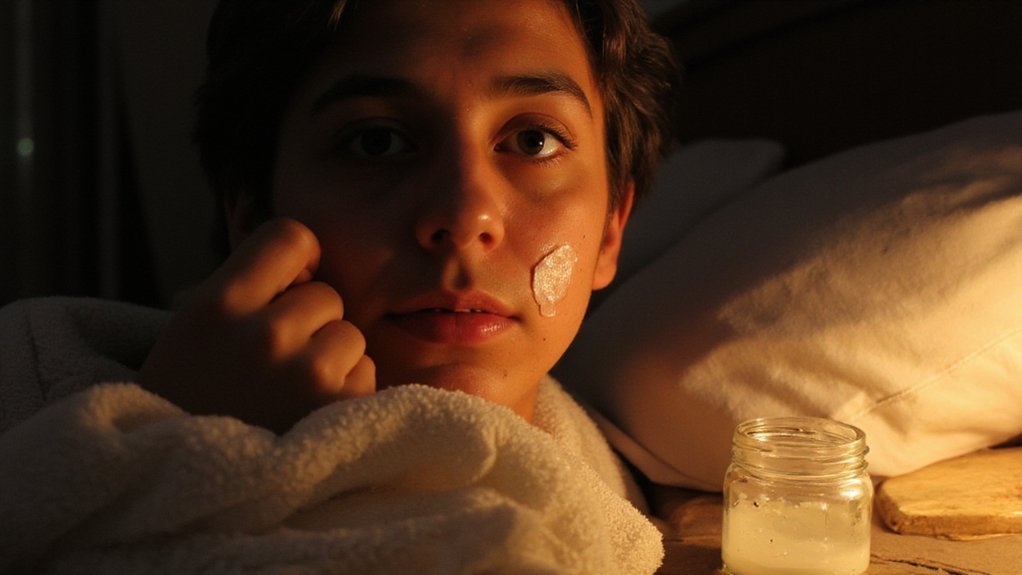You can’t erase every pimple in one night, but you can sharply reduce redness, swelling and pus with a few proven steps. Start by cooling the area, then apply a targeted OTC product such as benzoyl peroxide, salicylic acid or a hydrocolloid patch. Use gentle cleansing and avoid heavy makeup. If you want the safest, fastest routine dermatologists recommend, keep going.
Key Takeaways
- You can’t fully eliminate acne overnight, but you can reduce swelling, redness, and bacterial load to make a lesion less noticeable by morning.
- Apply a clean ice pack for 5–10 minutes to reduce immediate swelling and pain.
- Spot-treat with benzoyl peroxide (2.5–5%) or salicylic acid (0.5–2%) after cleansing to kill bacteria and unclog the pore.
- Use a hydrocolloid patch on open or pus-filled lesions to absorb fluid and protect from picking overnight.
- Sleep on a clean pillowcase, avoid touching the face, and elevate your head slightly to minimize mechanical irritation and oil buildup.
Why Pimples Appear Overnight

You might wonder why a new pimple seems to erupt by morning. Often it’s not magic but rapid follicular events: sebum, dead cells and trapped bacteria create a microenvironment that causes inflammation. During sleep, skin repair and hormonal fluctuations change sebum production and barrier function, so you may wake with swelling. Mechanical irritation — sleeping on a contaminated pillowcase or touching your face — transfers skin bacteria and can accelerate lesion formation. Acute hormonal rises, like cortisol at night or menstrual-cycle shifts, increase oiliness and immune reactivity, promoting faster visible results. Some medications and topical products occlude follicles, speeding blockage. Genetics and baseline acne severity determine how fast a lesion matures; innovative topical formulations aim to modulate sebaceous activity and microbiome balance to reduce rapid flare-ups. Understanding these mechanisms helps you target prevention rather than react to overnight appearance. You’ll plan strategies informed by science and data now.
Immediate Do-It-Yourself Treatments

When a pimple erupts overnight, act quickly with proven, low-risk measures to reduce inflammation and size: apply a clean ice pack for 5–10 minutes to constrict blood vessels and calm swelling, then use a small amount of a benzoyl peroxide spot treatment (2.5–5%) to kill Cutibacterium acnes and reduce pus, or a salicylic acid product (0.5–2%) to promote follicular exfoliation; for open or weeping lesions, a hydrocolloid patch will absorb fluid and protect the area while preventing picking. After initial steps, cleanse gently with a pH-balanced cleanser, pat dry, and avoid scrubbing or picking. Use an ice compress briefly if pain or warmth continue. For a low-risk antimicrobial option, try diluted tea tree oil as a spot test first. Sleep on a clean pillowcase, elevate your head, and skip heavy makeup. These actions won’t erase a pimple overnight but will reduce redness and size for morning photos, too.
Top Over-the-Counter Ingredients That Work Fast

After your quick first-aid steps, target proven over-the-counter actives that work fast on the mechanisms behind a fresh breakout. You’ll want ingredients that reduce oil, clear pores, kill bacteria and calm inflammation. Salicylic acid penetrates and exfoliates inside the follicle; benzoyl peroxide reduces Cutibacterium acnes and oxygenates clogged pores. Niacinamide and sulfur can reduce redness and sebum; adapalene (a topical retinoid available OTC) normalizes cell turnover overnight.
| Ingredient | Primary Action | Typical Use |
|---|---|---|
| Salicylic acid | Pore exfoliant | Cleanser/spot gel |
| Benzoyl peroxide | Antimicrobial | Wash/cream/spot |
| Adapalene | Comedolytic | Thin nightly gel |
Choose a formulation matched to your skin type and patch-test new actives. Start with a single targeted ingredient to measure response; escalate complexity only if needed. These options are evidence-based, fast-acting, and compatible with innovative routines. Monitor irritation and adjust frequency; combine actives thoughtfully to avoid excess dryness and preserve barrier function while accelerating lesion resolution for rapid, safe results consistently.
How to Apply Spot Treatments Safely
While targeting a blemish with a spot treatment can speed resolution, you’ll want to apply it precisely and sparingly to avoid irritation and barrier damage. Begin with clean, dry skin; active ingredients like benzoyl peroxide or salicylic acid work best when they contact the lesion directly. Use targeted tools (cotton swab or clean fingertip) and a pea-sized amount, tapping lightly to localize product.
- Start with a patch test behind the ear or jawline.
- Layer only one active at a time; wait thirty minutes before adding moisturizer.
- Stop use if persistent redness, burning, or peeling occurs.
These spot treatment techniques prioritize safe application and minimize collateral dryness. Track results nightly and adjust frequency based on tolerance. If you use prescription topicals, coordinate timing to prevent overlap. For faster, reliable outcomes, choose proven concentrations and follow directions—precision beats quantity. Consult a dermatologist for tailored escalation when irritation or recurrence persists.
Home Remedies to Avoid
Since you’ve been targeting blemishes with concentrated actives, be cautious about DIY fixes that promise overnight cures. You’ll encounter many “natural alternatives” touted online; some are soothing, but few have rigorous efficacy data. Avoid lemon juice, toothpaste, and undiluted essential oils — they irritate skin, disrupt barrier function, and can worsen inflammation. Pore-popping or aggressive scrubs cause microtears and scarring. Cold compresses can reduce swelling short-term, but won’t eliminate lesions. Treat claims skeptically and prioritize treatments with clinical evidence.
| Remedy | Problem |
|---|---|
| Lemon juice | Acid burns, irritation |
| Toothpaste | Drying, chemical irritation |
| Pore-popping | Scarring, infection |
When you need rapid improvement, consult validated spot therapies rather than relying on unproven, ineffective methods. Document results, stop if irritation appears, and integrate proven actives gradually to innovate your routine while preserving skin integrity. Seek dermatologist input for accelerated, safe strategies.
Preventing Nighttime Breakouts
If you want to reduce nighttime breakouts, focus on barrier-friendly habits that limit oil, bacteria, and friction while you sleep. You’ll optimize a targeted skincare routine and nighttime hygiene that prevents pore-clogging activity without stripping moisture. Cleanse gently, apply a lightweight non-comedogenic moisturizer, and use spot-treatments only where needed. Swap cotton pillowcases for silk or clean your bedding weekly to cut mechanical irritation and microbial transfer.
Reduce nighttime breakouts with barrier-friendly habits: gentle cleansing, lightweight moisturizer, and clean, breathable bedding.
- Cleanse with a mild, pH-balanced formula nightly.
- Use breathable sleep fabrics and change pillowcases often.
- Apply single-actives (retinoid or benzoyl peroxide) per provider guidance.
Adopt these evidence-backed steps consistently; they reduce inflammation, normalize sebum, and limit bacterial proliferation. If you integrate small, innovative adjustments—like antimicrobial laundry additives or silk masks—you’ll reduce nocturnal triggers while keeping skin barrier function intact. Consistency, not harshness, drives overnight improvement. Track results weekly and tweak variables based on objective skin responses and product tolerability.
When to See a Dermatologist
If your acne is severe, widespread, or causing nodules or scarring, you should see a dermatologist promptly. You should also consult a specialist when over-the-counter and home treatments haven’t improved your skin after several weeks. A dermatologist can prescribe targeted therapies—topical retinoids, oral antibiotics, or isotretinoin—and create a plan to prevent scarring and recurrence.
Severe or Widespread Acne
When you have widespread inflammatory lesions—numerous papules, pustules, nodules, or cysts on your face, chest, or back—or you’re developing scarring, severe pain, or nodules, see a dermatologist promptly. Severe acne and widespread acne often need systemic therapy, targeted diagnostics, and monitoring to prevent permanent damage. Your dermatologist will assess severity, consider oral antibiotics, hormonal therapy, or isotretinoin when indicated, and run appropriate labs. Expect a personalized plan and follow-up.
- Rapid assessment and documentation of lesion distribution
- Evidence-based systemic treatment options and monitoring
- Scar prevention strategies and procedural interventions
Act quickly: early specialist intervention preserves skin integrity and leverages innovative therapies safely; don’t wait for spontaneous overnight resolution. You’ll receive education on adherence, side-effect management, and realistic timelines for visible improvement and ongoing outcome tracking.
Acne Unresponsive to Treatment
Because acne that doesn’t respond to consistent treatment within about 6–12 weeks often needs specialist care, see a dermatologist if you’ve followed prescribed regimens (or tried guideline-recommended OTC measures) and see no meaningful improvement, if lesions worsen or new nodules/cysts appear, if scarring, persistent inflammation, severe pain, or significant emotional distress develop, or if treatments cause intolerable side effects. A dermatologist evaluates causes of treatment resistance, assesses for nodulocystic disease, and investigates contributors like hormonal imbalance, medication interactions, or biofilm-related bacterial persistence. They’ll stage severity, use targeted diagnostics, and recommend evidence-based escalations — systemic antibiotics, hormonal therapy, isotretinoin, or procedural options — to interrupt chronic inflammation and prevent scarring. Seek specialist care promptly for tailored, innovative plans and monitored risk mitigation. Act early; outcomes, innovation, and safety improve.
